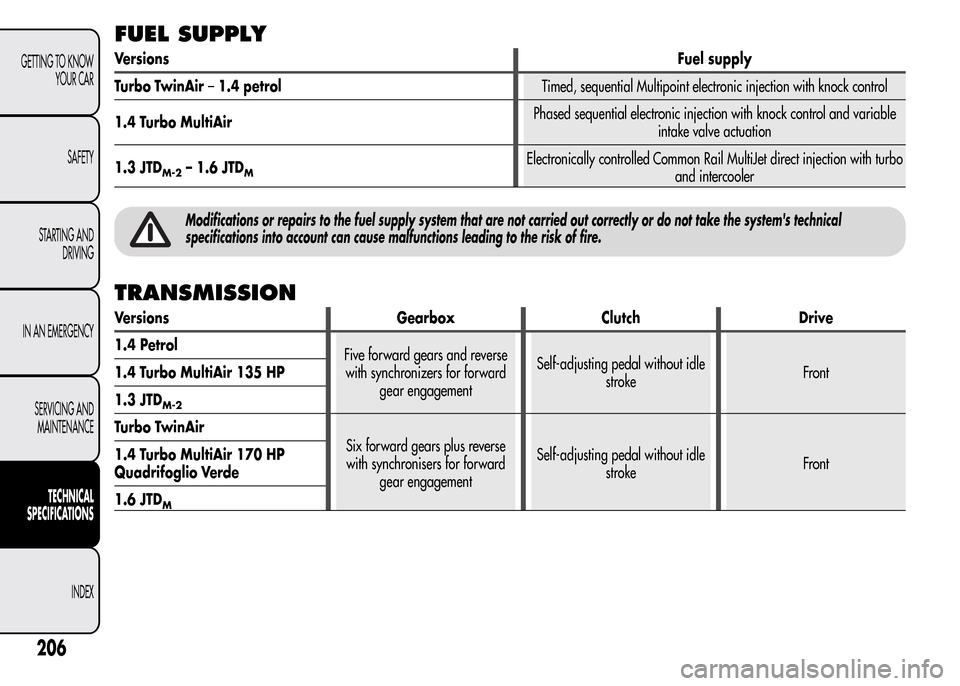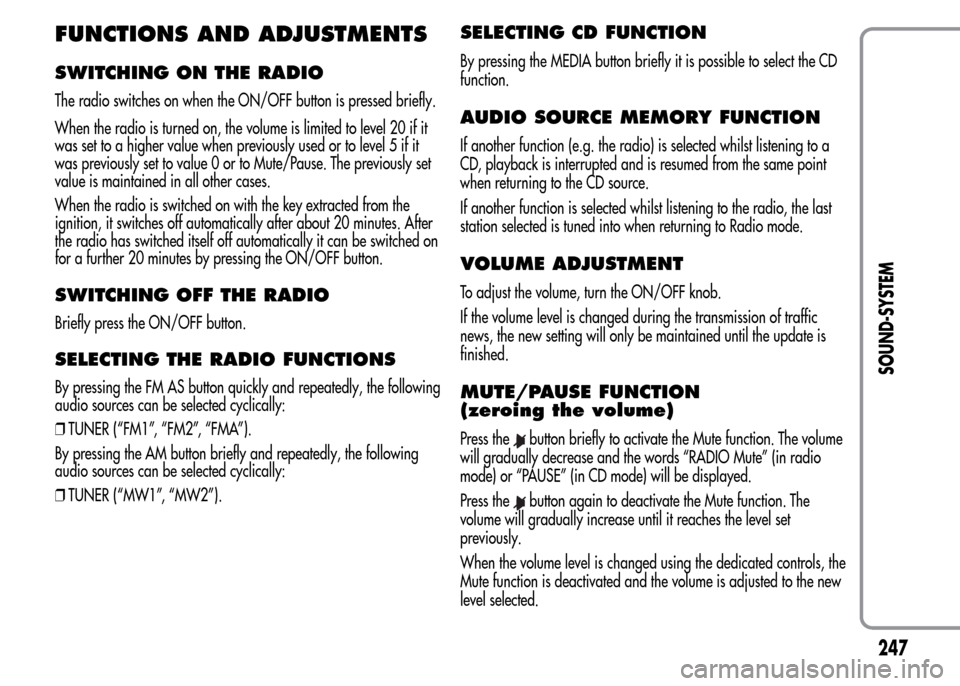2016 Alfa Romeo MiTo transmission
[x] Cancel search: transmissionPage 105 of 280

RADIO TRANSMITTERS AND MOBILE
PHONES
Radio transmitter equipment (vehicle mobile phones, CB radios,
amateur radio, etc.) cannot be used inside the car unless a separate
aerial is mounted externally.
IMPORTANT The use of similar devices inside the passenger
compartment (without separate aerial) produces radio-frequency
electromagnetic fields which, amplified by the resonance effects inside
the passenger compartment, may cause electrical systems equipping
the car to malfunction. This could compromise safety in addition to
constituting a potential hazard for the passengers.
In addition, transmission and reception of these devices may be
affected by the shielding effect of the car body.
As far as the use of EC-approved mobile phones is concerned (GSM,
GPRS, UMTS), follow the usage instructions provided by the mobile
phone manufacturer.
PARKING SENSORS
(for versions/markets, where provided)
The parking sensors are located in the car's rear bumper fig. 86 and
their function is to inform the driver, through an intermittent acoustic
signal, about the presence of obstacles behind the car.
ACTIVATION
The sensors are activated by engaging reverse gear. As the obstacle
behind the vehicle gets closer to the car, the acoustic signal becomes
more frequent.
fig. 86A0J0088
101
GETTING TO
KNOW YOUR CAR
SAFETY
STARTING AND
DRIVING
IN AN EMERGENCY
SERVICING AND
MAINTENANCE
TECHNICAL
SPECIFICATIONS
INDEX
Page 181 of 280

PERIODIC CHECKS
Every 1,000 km or before long journeys, check and restore the
following if necessary:
❒engine coolant, brake fluid and windscreen washer fluid level;
❒tyre inflation pressure and condition;
❒operation of lighting system (headlamps, direction indicators,
hazard warning lights, etc.);
❒operation of window washer/wiper system and positioning/wear of
windscreen/rear window wiper blades
Check and top up, if required, the engine oil level every 3,000 km.
HEAVY-DUTY USE OF THE CAR
If you use the car mainly under one of the following conditions:
❒towing a trailer or caravan;
❒dusty roads;
❒short, repeated journeys (less than 7-8 km) at sub-zero outside
temperatures;
❒engine often idling or driving long distances at low speeds or long
periods of idleness;
the following checks must be performed more frequently than indicated
in the Scheduled Servicing Plan:
❒check front disc brake pad conditions and wear;
❒check cleanliness of bonnet and boot locks, cleanliness and
lubrication of linkage;
❒visually inspect conditions of: engine, gearbox, transmission, pipes
and hoses (exhaust - fuel system - brakes) and rubber elements
(boots - sleeves - bushes - etc.);
❒check battery charge and battery fluid level (electrolyte);
❒visually inspect condition of the accessory drive belts;
❒check and, if necessary, change engine oil and replace oil filter;
❒check and, if necessary, replace pollen filter;
❒check and, if necessary, replace air cleaner.
177
GETTING TO KNOW
YOUR CAR
SAFETY
STARTING AND
DRIVING
IN AN EMERGENCY
SERVICING AND
MAINTENANCE
TECHNICAL
SPECIFICATIONS
INDEX
Page 210 of 280

FUEL SUPPLY
VersionsFuel supply
Turbo TwinAir–1.4 petrolTimed, sequential Multipoint electronic injection with knock control
1.4 Turbo MultiAirPhased sequential electronic injection with knock control and variable
intake valve actuation
1.3 JTD
M-2– 1.6 JTDMElectronically controlled Common Rail MultiJet direct injection with turbo
and intercooler
Modifications or repairs to the fuel supply system that are not carried out correctly or do not take the system's technical
specifications into account can cause malfunctions leading to the risk of fire.
TRANSMISSION
Versions Gearbox Clutch Drive
1.4 Petrol
Five forward gears and reverse
with synchronizers for forward
gear engagementSelf-adjusting pedal without idle
strokeFront 1.4 Turbo MultiAir 135 HP
1.3 JTD
M-2
Turbo TwinAir
Six forward gears plus reverse
with synchronisers for forward
gear engagementSelf-adjusting pedal without idle
strokeFront 1.4 Turbo MultiAir 170 HP
Quadrifoglio Verde
1.6 JTD
M
206
GETTING TO KNOW
YOUR CAR
SAFETY
STARTING AND
DRIVING
IN AN EMERGENCY
SERVICING AND
MAINTENANCE
TECHNICAL
SPECIFICATIONS
INDEX
Page 225 of 280

REFUELLING
Turbo TwinAir 1.4 Petrol
Prescribed fuels and
original lubricants
litres kg litres kg
Fuel tank 45 – 45 –
Unleaded petrol not less than 95
RON (EN 228 specification)
including a reserve of 5 - 7 – 5 - 7 –
Engine cooling system (with climate
control)5,4 5,3 5,2 4,6Mixture of 50% demineralised
water and 50% PARAFLU
UPfluid
(*)
Engine sump 2,8 2,5 2,7 2,3SELENIA DIGITEK P.E. (Turbo
TwinAir versions)
SELENIA StAR P.E. (1.4 Petrol
versions) Engine sump and filter 3,3 , 2,9 2,5
Differential/gearbox casing 1,65 1,5 1,6 1,4TUTELA TRANSMISSION
GEARFORCE
Hydraulic brake circuit with ABS
anti-lock device0,53 0,5 0,53 0,5 TUTELA TOP 4
Windscreen/rear window/
headlight washer fluid reservoir
(**)
2,2 (4,5) 1,9 (4,0) 2,8 (4,6) 2,5 (4,1)Mixture of water and TUTELA
PROFESSIONAL SC 35
(*) For particularly harsh climate conditions, a mixture of 60%UPand 40% demineralised water is recommended.
(**) Values in brackets refer to versions with headlight washers
221
GETTING TO KNOW
YOUR CAR
SAFETY
STARTING AND
DRIVING
IN AN EMERGENCY
SERVICING AND
MAINTENANCE
TECHNICAL
SPECIFICATIONS
INDEX
28
Page 226 of 280

1.4 Turbo MultiAir 1.3 JTDM-2Prescribed fuels and
original lubricants
litres kg litres kg
Fuel tank 45 – 45 –Unleaded petrol not less than 95
RON (EN 228 specification)
(1.4 Turbo MultiAir versions)
Diesel for motor vehicles
(EN590 specification) (1.3
JTD
M-2versions) including a reserve of 5 - 7 – 5 - 7 –
Engine cooling system (with climate
control)6,0 5,3 7,2 6,4Mixture of 50% demineralised
water and 50% PARAFLU
UPfluid
(*)
Engine sump 3,1 2,6 3,0 2,5SELENIADIGITEK P.E. (1.4 Turbo
MultiAir versions)
SELENIA WRFORWARD
(1.3
JTDversions) Engine sump and filter 3,5 3,0 3,2 2,7
Differential/gearbox casing 2.0 1.7 1.8 1.5TUTELA TRANSMISSION
GEARFORCE
Hydraulic brake circuit with ABS
anti-lock device0,53 0,5 0,53 0,5 TUTELA TOP 4
Windscreen/rear window/
headlight washer fluid reservoir
(**)
2,2 (4,5) 1,9 (4,0) 3,0 (6,0) 2,8 (5,6)Mixture of water and TUTELA
PROFESSIONAL SC 35
(*) For particularly harsh climate conditions, a mixture of 60%UPand 40% demineralised water is recommended.
(**) Values in brackets refer to versions with headlight washers
222
GETTING TO KNOW
YOUR CAR
SAFETY
STARTING AND
DRIVING
IN AN EMERGENCY
SERVICING AND
MAINTENANCE
TECHNICAL
SPECIFICATIONS
INDEX
Page 227 of 280

1.6 JTDMPrescribed fuels and
original lubricants
litres kg
Fuel tank 45 –
Diesel for automotive engines (EN 590
Specification)
including a reserve of 5 - 7 –
Engine cooling system (with climate control) 5,7 5,0Mixture of 50% demineralised water and
50% PARAFLU
UPfluid(*)
Engine sump 4,3 3,6
SELENIA WRFORWARD
Engine sump and filter 4,6 3,9
Differential/gearbox casing 2.0 1.7 TUTELA TRANSMISSION GEARFORCE
Hydraulic brake circuit with ABS anti-lock device 0,53 0,5 TUTELA TOP 4
Windscreen/rear window/headlight washer fluid
reservoir
(**)3,0 (6,0) 2,8 (5,6)Mixture of water and TUTELA
PROFESSIONAL SC 35
(*) For particularly harsh climate conditions, a mixture of 60%UPand 40% demineralised water is recommended.
(**) Values in brackets refer to versions with headlight washers
223
GETTING TO KNOW
YOUR CAR
SAFETY
STARTING AND
DRIVING
IN AN EMERGENCY
SERVICING AND
MAINTENANCE
TECHNICAL
SPECIFICATIONS
INDEX
Page 229 of 280

UseFluid and lubricant features for a correct use
of the carGenuine fluids and
lubricantsApplications
Lubricants and
greases for drive
transmission
systemSAE 75W grade synthetic lubricant.
Specification 9.55550-MZ6.TUTELA
TRANSMISSION
GEARFORCE
Contractual Technical
Reference No. F002.F10Gearboxes and
differentials
(mechanical)
Molybdenum disulphide grease, for use at high
temperatures. NL.G.I. 1-2 consistency
9.55580 specificationTUTELA ALL STAR
Contractual Technical
Reference No. F702.G07Wheel side constant
velocity joints
Grease for constant velocity joints with low friction
coefficient. NL.GI. 0-1 consistency
9.55580 specificationTUTELA STAR 700
Contractual Technical
Reference No. F701.C07Differential side constant
velocity joints
Brake fluidSynthetic fluid for brake and clutch systems. Exceeds
specifications: FMVSS no. 116 DOT 4, ISO 4925,
SAE J1704,
9.55597 specificationTUTELA TOP 4
Contractual Technical
Reference No. F001.A93Brake and clutch
hydraulic controls
225
GETTING TO KNOW
YOUR CAR
SAFETY
STARTING AND
DRIVING
IN AN EMERGENCY
SERVICING AND
MAINTENANCE
TECHNICAL
SPECIFICATIONS
INDEX
Page 251 of 280

FUNCTIONS AND ADJUSTMENTS
SWITCHING ON THE RADIO
The radio switches on when the ON/OFF button is pressed briefly.
When the radio is turned on, the volume is limited to level 20 if it
was set to a higher value when previously used or to level 5 if it
was previously set to value 0 or to Mute/Pause. The previously set
value is maintained in all other cases.
When the radio is switched on with the key extracted from the
ignition, it switches off automatically after about 20 minutes. After
the radio has switched itself off automatically it can be switched on
for a further 20 minutes by pressing the ON/OFF button.
SWITCHING OFF THE RADIO
Briefly press the ON/OFF button.
SELECTING THE RADIO FUNCTIONS
By pressing the FM AS button quickly and repeatedly, the following
audio sources can be selected cyclically:
❒TUNER (“FM1”, “FM2”, “FMA”).
By pressing the AM button briefly and repeatedly, the following
audio sources can be selected cyclically:
❒TUNER (“MW1”, “MW2”).
SELECTING CD FUNCTION
By pressing the MEDIA button briefly it is possible to select the CD
function.
AUDIO SOURCE MEMORY FUNCTION
If another function (e.g. the radio) is selected whilst listening to a
CD, playback is interrupted and is resumed from the same point
when returning to the CD source.
If another function is selected whilst listening to the radio, the last
station selected is tuned into when returning to Radio mode.
VOLUME ADJUSTMENT
To adjust the volume, turn the ON/OFF knob.
If the volume level is changed during the transmission of traffic
news, the new setting will only be maintained until the update is
finished.
MUTE/PAUSE FUNCTION
(zeroing the volume)
Press thebutton briefly to activate the Mute function. The volume
will gradually decrease and the words “RADIO Mute” (in radio
mode) or “PAUSE” (in CD mode) will be displayed.
Press the
button again to deactivate the Mute function. The
volume will gradually increase until it reaches the level set
previously.
When the volume level is changed using the dedicated controls, the
Mute function is deactivated and the volume is adjusted to the new
level selected.
247
SOUND-SYSTEM